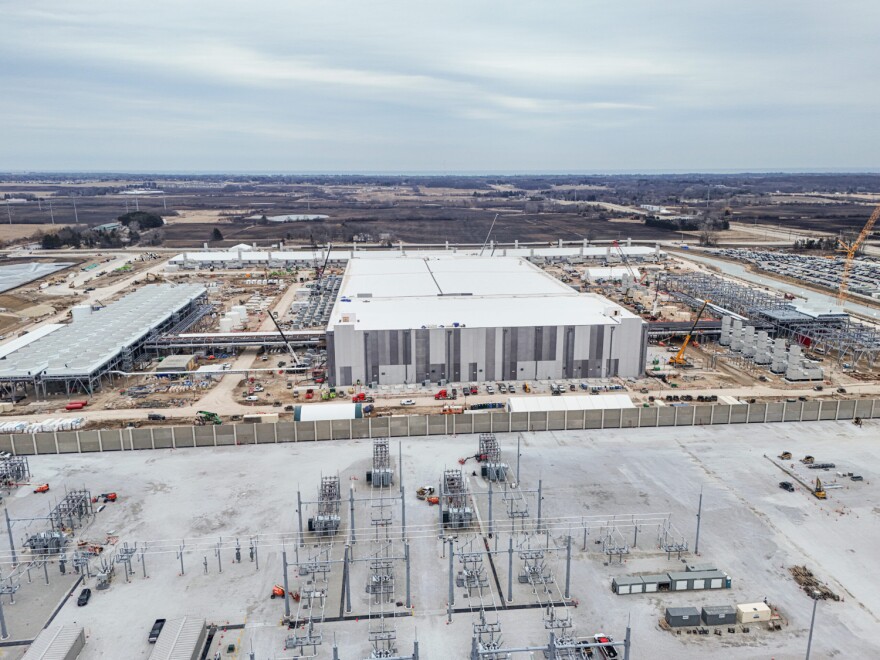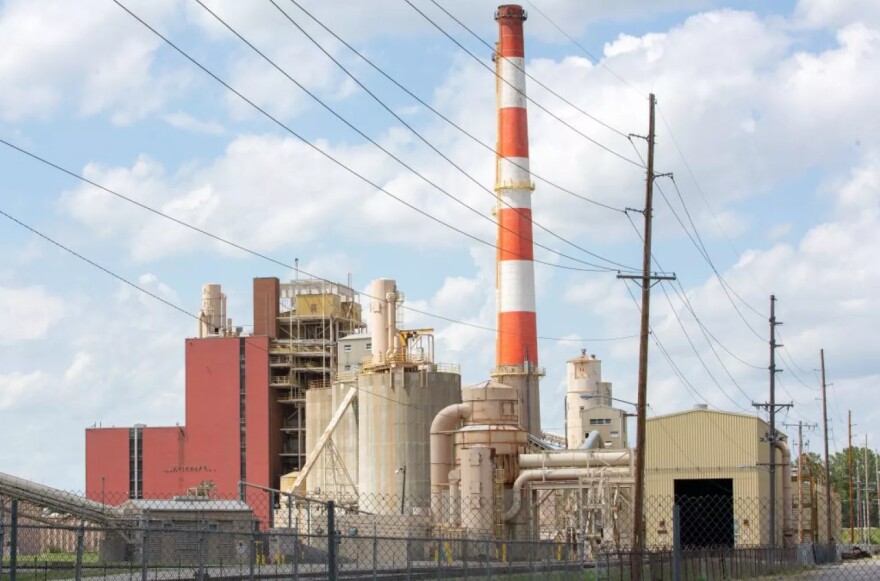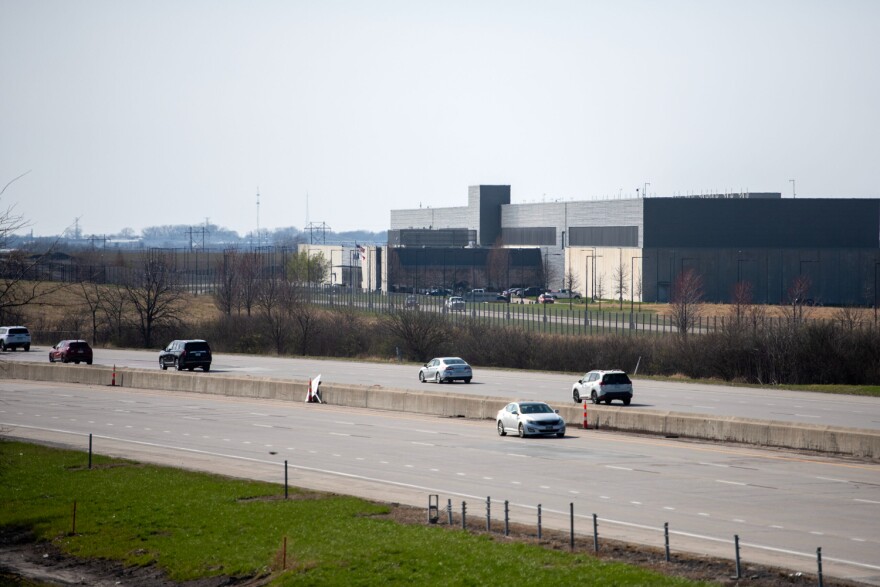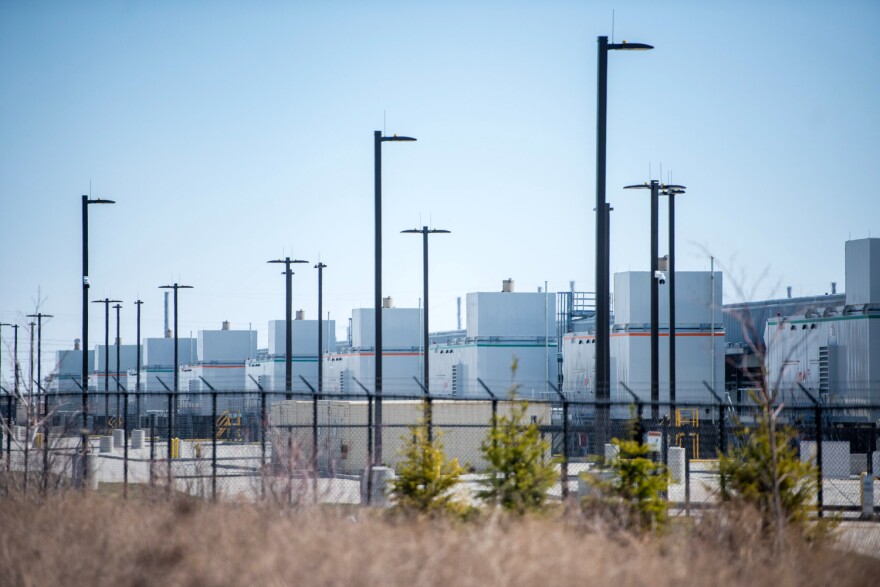In rural Dane County, Wisconsin, a developer wants to build a data center campus with 15 buildings over the next decade.
Texas will serve as the home base for Stargate, a $500 billion effort to build artificial intelligence infrastructure, with 10 data centers under construction and 10 more planned.
In Kansas City, Kansas, developers are looking to build a data center at a defunct power plant.
Data centers are expanding across the U.S. to meet growing demand for artificial intelligence, but their growth also raises thorny questions over resources.
The centers are among the most energy-intensive types of buildings, consuming 10 to 50 times the energy of a commercial office building, according to the U.S. Department of Energy. A 2024 federal report found data centers consumed about 4.4% of the nation’s electricity in 2023 and that could nearly triple to 12% by 2028.
They can also be water-intensive buildings. For example, Google’s U.S. data centers consumed 12.7 billion liters of fresh water for cooling in 2021, according to the University of California Riverside. Three years later, the company consumed more than 30 billion liters. UC Riverside estimates that running 20 to 50 ChatGPT queries uses roughly half a liter of fresh water.
Zack Pistora, director of the Sierra Club’s Kansas chapter, said he believes the tech companies behind data centers have a responsibility to work to mitigate the environmental impacts of their developments.
“These are some of the richest companies in America, and maybe across the world,” he said. “To ask them to make sure that residents don't pay more in terms of their electric or water bills, [or] to do right by choosing the right energy sources to not pollute the community or the planet, we feel isn't too much to ask.”
Efforts to use less water
In Wisconsin, Virginia-based QTS Data Centers is planning the campus of 15 buildings in the town of Vienna.
Tag Greason, co-CEO, said the company wants to do so using methods that will cut down on water consumption. He said QTS will use a system requiring no-water with a refrigerant or a “closed-loop” system that requires a one-time input of water that is then recycled.
“Depending on what the customer needs, we may want a refrigerant, or we may actually want the closed loop,” Greason said, noting the company already uses that technology at projects in Arizona and Texas.
QTS Data Centers said those methods save more than 48 million gallons of water annually in the operation of each data center.

In the southeastern part of Wisconsin, Microsoft is also working on a data center campus. The company has said most of its Mount Pleasant data center campus will use a new closed-loop system design that will consume zero water for cooling.
Yet cooling data centers without consuming water makes them more energy-intensive, according to Shaolei Ren, an associate professor of electrical and computer engineering at the University of California, Riverside.
“If you use more energy, there will be more carbon footprint,” he said. “And similarly, you're going to be increasing the indirect water consumption for generating electricity, because generating electricity uses a lot of water as well.”
He points to the differences in energy efficiency between a pair of Google data centers in Nevada as an example; one in Reno and another in Las Vegas. Ren said Google’s Las Vegas data center uses a lot of water for cooling, while the Reno data center doesn’t use water.
In comparing the sites’ power usage effectiveness, or PUE, he found Reno uses almost twice the energy.
“You can reuse these refrigerants to eliminate the downside water usage, but the problem is you're going to be increasing the energy consumption,” he said.
Ren added that those tradeoffs pose a difficult choice: reduce freshwater use but accept higher electricity demand — potentially from climate change-causing fossil fuels.
Drawing down energy
In Texas, a new report from an electric grid reliability watchdog group found that “the disorganized integration” of large load customers, like data centers, posed the “largest increased risk” to the state’s electric grid.
Texas has 363 data centers across the state, according to the Data Center Map, a research tool that tracks data center development. And more are on the way in the Lone Star State. According to the Texas Reliability Entity’s report, the region is forecasting “unprecedented load growth” driven by new data centers and artificial intelligence.
“When I saw some of the load patterns for AI data centers, it reminded me of a steel mill,” said David Penney, director of reliability services for the Texas Reliability Entity, during a recent regulatory meeting. “Very fast, very large ramps up and down, which creates issues for operators on the grid. They've got to be able to manage those sharp load swings.”
Those projected increases in demand have raised concerns that utilities across the country will look to meet the projected load growth through fossil fuels, like coal or natural gas, rather than renewable energy.
For example, Wisconsin’s largest electric utility recently received approval from regulators to build two new natural gas power plants to support data center and industrial growth, as well as announced plans to delay the closure of a coal-fired power plant by one year.
The Sierra Club has called on the tech companies behind data centers to take a more active role in supporting the clean energy transition, and called on regulators to require new large customers to be transparent about their load projections.
Energy and economics
The Kansas City area is scrambling to attract data centers in both Missouri and Kansas. While neither state is a hotspot for development yet, environmentalists are watching closely as developers circle.
A company called PowerTransitions is looking to build a data center at the site of a defunct power station in Kansas City, Kansas, for instance. The plant shut down coal usage around 10 years ago but kept oil burners at the site, said Ty Gorman, a senior campaign organizing strategist at the Sierra Club’s Kansas chapter.

The data center will need 192 megawatts of power, Gorman said.
“The details of that aren't approved yet, just the zoning and the sale are approved,” he said. “There's still a community benefits and power agreement to be hashed out with that data center.”
Because the Kansas City Board of Public Utilities, which serves Kansas City, Kansas, is a municipal utility, rather than an investor-owned utility, Gorman said his hope is that it would look to meet increased electricity demand through clean energy instead of fossil fuel generation.
“Investor-owned utilities have a profit motive to own everything and own the most expensive things they can get approved,” he said. “And BPU does not, so it would seem like the data center would be able to go towards the cheapest option, which would be solar and storage.”
Even so, Gorman also said data centers boosting demand does pose real risks to the clean energy transition and efforts to reduce the impacts of climate change.
“The threat of data centers to a livable planet, I think, is very real, and we're at a tipping point as far as how we deal with the increased requirements to meet this electric need over the next few years,” he added.
Where water can’t be replaced
The Iowa Geological Survey warns that while data centers don’t pose an immediate risk to the state’s water supply, Iowa needs to more strategically plan for using its groundwater to avoid risks in the future.
The state is home to 104 data centers, with 76 in the Des Moines market, according to Data Center Map.
Microsoft used 68.5 million gallons of water in West Des Moines for its five data center campuses last year, making it the city’s largest water user.
Keith Schilling, state geologist of Iowa and director of the Iowa Geological Survey, said the impacts of data centers on Iowa’s groundwater will vary across the state.
“Our groundwater is not evenly distributed across the state,” he said. “We have areas that can provide a lot of high quality water with minimal impact, and others [where] aquifers might be stressed by these new water demands.”

Schilling said there are shallow aquifers around Des Moines that are recharged by precipitation but are also vulnerable to drought and high nitrate concentrations in rivers.
He said some data centers around the Des Moines area are using deep aquifer water that’s thousands of years old — and it won’t be replaced.
“All water lost to this deep aquifer is lost forever in human terms,” he said. “In other areas where we have shallow, plentiful water — eastern Iowa or the Missouri River alluvium — data centers are perfectly appropriate. That water is readily recharged and turned over, and it can supply much larger quantities of water.”
Schilling hopes communities encouraging data center development will consider the sustainability of their groundwater supply before signing-off on a new large-scale water user.
This story was produced in partnership with Harvest Public Media, a collaboration of public media newsrooms in the Midwest. It reports on food systems, agriculture and rural issues.




![Dust storm approaching Bloomington, Illinois. [Photo courtesy of Chicago NWS and Jason Borchardt.]](https://npr.brightspotcdn.com/dims4/default/c2bc811/2147483647/strip/true/crop/1011x563+0+135/resize/280x156!/quality/90/?url=http%3A%2F%2Fnpr-brightspot.s3.amazonaws.com%2F68%2Fe6%2F5c0231a84edabc4144f1191a4d45%2Fjasonborchardt-bloomington1-jpg.jpeg)
